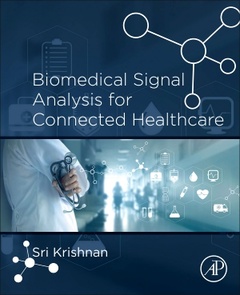Biomedical Signal Analysis for Connected Healthcare
Auteur : Krishnan Sridhar

Biomedical Signal Analysis for Connected Healthcare provides rigorous coverage on several generations of techniques, including time domain approaches for event detection, spectral analysis for interpretation of clinical events of interest, time-varying signal processing for understanding dynamical aspects of complex biomedical systems, the application of machine learning principles in enhanced clinical decision-making, the application of sparse techniques and compressive sensing in providing low-power applications that are essential for wearable designs, the emerging paradigms of the Internet of Things, and connected healthcare.
1. Types and characteristics of biomedical signals2. Time-domain processing of biomedical signals3. Spectral-domain analysis of biomedical signals4. Wavelet analysis of biomedical signals5. Time-frequency analysis of biomedical signals6. Sparse and compressive sensing techniques for biomedical signals7. Machine learning for interpreting biomedical signals8. Wearables and Internet of Things for connected healthcare
Biomedical, electrical, and computer engineers, researchers in connected healthcare and in biomedical signal analysis.
- Provides comprehensive coverage of biomedical engineering, technologies, and healthcare applications of various physiological signals
- Covers vital signals, including ECG, EEG, EMG and body sounds
- Includes case studies and MATLAB code for selected applications
Date de parution : 06-2021
Ouvrage de 334 p.
19x23.3 cm
Thèmes de Biomedical Signal Analysis for Connected Healthcare :
Mots-clés :
Accelerometer sensors; Adaptive segmentation; Affordable health technology; Auscultation; Autoregressive modeling; Bioacoustics; Bluetooth; Causality; Clustering; Compressive sensing; Connected healthcare; COVID-19 pandemic tracking; Cross validation; Data compression; Decision support systems; Decision trees; Deep learning; Delta modulation; Digital health; Digital modulation; ECG wearables; ECG; Edge ML; EEG wearables; EEG; EHR; Electronic circuits; EMG wearables; EMG; Empirical mode decomposition; EMR; Ensemble learning; Entropy; Ethics and fairness in AI; F1score; Filter realization; FIR filters; Gait; Healthcare; IoT; and AI; Heart rate; HIPAA; HL7Low-cost digital technology; Human factors; IIR filters; Internet of things (IoT)Internet of medical things (IoMT)PPG; K-means; k-NN; Least mean squares algorithm; Linear discriminant analysis; Linear systems; Logistic regression; Mathematical modeling; Moving average; Naïve Bayes; Neural networks; Nonstationarity; Normal equation; Overfitting; Pan-Tompkins; Parametric representation; Pattern recognition; Physiological signals; PPG sensor; Pulse code modulation; Quantization; Receiver operating characteristics; Region of Convergence; Reinforcement learning; Remote monitoring; Sampling; Savitzky-Golay filters; Semisupervised learning; Sensitivity; Sleep and activity monitoring; Sparsity; Specificity; Spectral estimation; Spectral features; Spectrogram; Stability; Supervised learning; Support vector machines; Telemedicine; Time-domain features; Tiny ML; Unsupervised learning; User experience; Vital signs monitoring; Wavelet transform; Wearables; WiFi; Wigner-Ville distribution; Zigbee



